The superhospital’s archives include paintings, photographs and historical medical objects that offer a fascinating glimpse at how far care has advanced.
Article content
For good luck, Royal Victoria Hospital nurses used to rub the left knee of the statue of Queen Victoria, who held court for decades at the hospital’s legacy site up on the flank of Mount Royal.
Then in 2014, the four-ton white Carrara marble statue representing the long-reigning queen was transported to the McGill University Health Centre’s new Glen campus in Notre-Dame-de-Grâce — before the walls were even up.
“It was just steel beams and concrete,” recalled Alexandra Kirsh, curator of the RBC Art and Heritage Centre of the MUHC. “She was our first resident at the new hospital site.”
Advertisement 2
Story continues below
Article content
In addition to that first resident, the MUHC is home to all kinds of treasures in the form of art, of objects that speak to its medical and cultural heritage, and of archives. On its walls and in display cases, they trace a rich history.
When the RBC Art and Heritage Centre was created in 2013, its initial focus was preparing for the 2015 move to the Glen campus of three of the MUHC’s founding hospitals: the Royal Victoria, the Montreal Children’s and the Montreal Chest Institute. When Kirsh started, nothing had been registered or inventoried. Since then more than 3,000 objects, some of which were unearthed in hospital attics or basements, have been photographed, numbered and catalogued and are being integrated into a database that eventually will be online. “And there is plenty more to do,” she said.
Following an initial assessment, the collection — roughly one-third art, one-third medical and other historical objects and one-third archives — was moved from the hospitals’ legacy sites to its current location, a temporary holding area not far from the Glen campus where items are stored until they can be displayed.
Advertisement 3
Story continues below
Article content
“We are trying to think critically about what art goes in what spaces,” Kirsh told artist Shelley Miller in a podcast in June. “What is appropriate? If patients are anxious, we don’t want to exacerbate things. What about the people waiting? What can we do?”
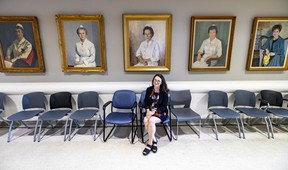
Many people are intimidated by museums or art galleries, Kirsh acknowledged, but she is interested in the reception of art outside museums. “We are showcasing the cultural life of the hospital and using this non-traditional exhibition space to change, and ultimately improve, people’s experience in the hospital,” she said.
Kirsh, a Toronto native, has a background in fine arts and moved into art history and collection management. She had started a PhD at Concordia University to continue her study of art in hospitals when she was recruited to the RBC Art and Heritage Centre by its director, Dr. Jonathan Meakins.
“Art is an opportunity; it improves the environment for staff and for patients and their family members,” she said. “It can be meaningful in different ways: It’s there for entertainment, as education, for distraction or to calm people and provide solace.”
Article content
Advertisement 4
Story continues below
Article content
To Kirsh, “everybody has their own relationship with art: It’s a universal language that speaks to everyone uniquely. My goal is to ensure that each person finds something that resonates with them.”
The intent is to tailor artworks to address needs of staff, patients and family members, she said. Kirsh interviews staff to learn the needs in a particular area. “They know the patients best and know best how the space functions on a daily basis,” she said. “And if I have a collection I feel will suit an area or department well, I will approach the staff in that department and start a dialogue about what could work best for the space.”
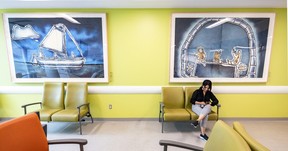
Some of what is already hanging at the Glen campus:
Kirsh unearthed a series of eight prints by Montreal artist Miyuki Tanobe illustrating Gabrielle Roy’s 1945 novel The Tin Flute, set in St-Henri: Tanobe is known for her depiction of everyday Montreal scenes. In the Montreal Children’s Tupper St. location, the prints hung in various locations: Now they’re exhibited together in the Montreal Children’s on the Glen campus.
Art by Inuk artist Elisapee Ishulutaq (1925-2018), a gift from a master printmaker who worked with her, Paul Machnik, is displayed in a gallery of her work located just outside the MUHC’s Northern and Indigenous Child Health offices. “We want to make sure that we are always creating safe spaces for all of our communities,” said Kirsh. Other First Nations artists in the collection include Germaine Arnaktauyok and Ooloosie Saila.
Advertisement 5
Story continues below
Article content
Lilias Torrance Newton (1896-1980), one of the more important 20th-century portrait artists in Canada, painted the portrait of Mabel Frances Hersey (1872-1943), Superintendent of Nurses and the Training School at the Royal Victoria Hospital at the outbreak of the First World War. Her portrait is among those of former Royal Victoria head nurses which once hung at the legacy site and today are in the Glen campus. Newton was a founding member of the Beaver Hall Group, a Montreal-based group of Canadian painters in the early 1920s.
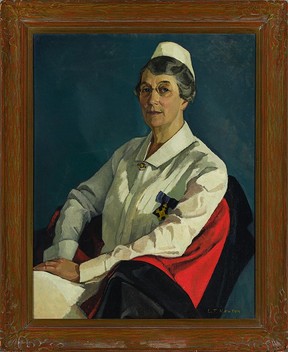
For his co-discovery of insulin and its therapeutic potential, Dr. Frederick Banting (1891-1941) was awarded the Nobel prize with John Macleod, his boss at the University of Toronto. Banting, an amateur artist, was friendly with the Group of Seven, a group of Canadian landscape painters (1920-1933). He painted Winter in the Laurentians, a silkscreen print in the RBC Art and Heritage Centre collection, during a trip with the Group of Seven’s A.Y. Jackson. Banting was a colleague and friend of a number of Montreal physicians; his work speaks to a legacy of collaboration between medicine and the arts, said Kirsh, and shows that there were doctors who were broad thinkers and engaged in all aspects of life.
Advertisement 6
Story continues below
Article content
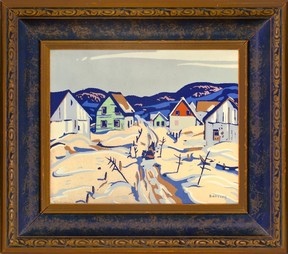
Dr. Norman Bethune (1890-1939) was also part of that community: His 1935 painting Night Operating Theatre depicts a team of doctors, nurses and orderlies in a Royal Victoria operating theatre, working. The painting hangs outside the resource centre at the Glen campus, near the main entrance, part of a display featuring items relating to Bethune and his career. The display also features a 1933 photograph, part of the MUHC archive collection, of thoracic surgeon Edward William Archibald in an RVH operating theatre, with Bethune, also a thoracic surgeon, to his right.
Bethune, an early advocate of universal health care in Canada, belonged to the Communist Party and, as a volunteer during the Spanish Civil War, pioneered mobile blood transfusion units. In 1938, during the second Sino-Japanese War, he travelled to China and became a battlefield surgeon for Chinese Communist forces — and a hero in the People’s Republic of China. The following year, a scalpel slipped during an operation and lacerated his finger; in an era before surgical gloves and universal precautions, the finger became infected and Bethune died of sepsis.
Advertisement 7
Story continues below
Article content
Night Operating Theatre, which was part of a 1935 spring exhibition at the Montreal Museum of Fine Arts, was not Bethune’s first artistic venture: As a sanatorium patient after contracting tuberculosis in the late 1920s, he painted a series of murals depicting his experience. He continued to draw, supported art organizations and became friendly with accomplished artists including Fritz Brandtner. The two gave painting lessons as volunteers to young hospital patients and Bethune started an arts school for disadvantaged children which he ran on Saturday mornings from his apartment.
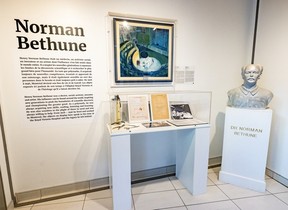
Included among works in the collection of the RBC Art and Heritage Centre are a small painting by 19th-century Canadian modernist artist James Wilson Morrice, a black-and-white work by the 20th-century Spanish painter and sculptor Joan Miró, two paintings by Marcel Barbeau, and works by such well-known Canadian artists as Louis Muhlstock and Joe Fafard. For now, these are in storage but they will go up on walls soon, said Kirsh.
The intention, as art is moved from the holding area and hung, is to acquire new works, she said, and she wants for the work to cover a range of styles and subjects. There is no budget for acquisitions, although tax receipts for donations are given. The centre has an advisory board and an acquisition committee to vet donations “and there are conversations about how we would like to see the collection go forward.”
Advertisement 8
Story continues below
Article content
For her part, “I like to create galleries,” Kirsh said. “Ideally, each unit, clinic or waiting room will be a curated gallery in which you get to know an artist, a medium or a concept.”
Moody, meditative photographs of the natural world by Brooklyn artist and former Montrealer Amanda Marchand, for instance, hang in the Royal Victoria inpatient unit. Marchand, whose mother was a patient on the unit, was interested in a collaboration and Kirsh “knew the work would integrate well in that space.”
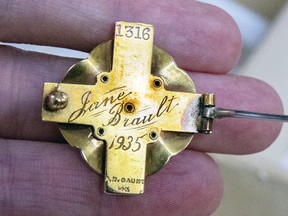
Entr’acte, a curated gallery of photographs in the emergency department, depicts the legacy site of the Royal Victoria as captured by 11 contemporary Montreal artists. In 2017 Kirsh took the artists, all photographers, to the empty building and they walked through the complex looking for spaces or features they especially liked or that spoke to them. Their images portray the building “as it is suspended between functions” and the 11 photos are now part of the MUHC permanent collection.
In the radiology area of the Cedars Cancer Centre on the Glen campus, Kirsh wanted something colourful and uplifting: She chose from the collection a series of linocuts by Pablo Picasso and posters of cutout works by Henri Matisse — cut-paper collages he began to create when cancer surgery left him unable to paint or sculpt. The two artists were rivals but, after Matisse got sick, Picasso wrote him letters of support — and Matisse began to create the collages, she explained. The Matisse posters originally hung at the Montreal Children’s but Kirsh felt they were more appropriate in the Cancer Centre with the Picassos, which were a donation made just after the 2015 move to the Glen campus.
Advertisement 9
Story continues below
Article content
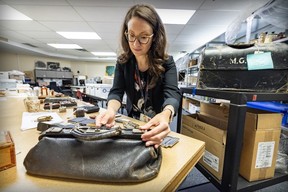
The hospitals’ cultural and medical heritage is also important — it’s the Art and Heritage Centre, after all — and display cases at the Glen campus include such items as nursing uniforms: Nurses no longer wear caps but the pointed ones of Royal Victoria nurses and the more poofy versions of Montreal General nurses are displayed on the second floor of the Royal Victoria’s C pavilion. In display cases in the cafeteria area, dishware and cutlery used by patients, staff and visitors document how the objects and their patterns evolved over time, Kirsh explained. Salt spoons, for instance, were used in earlier years, when salt cellars still had a place on tables; flatware, initially monogrammed, came to be machine-stamped.
If Kirsh brought extensive knowledge about art to her job, learning about medicine through its history has proved an enlightening journey. Images and displays of historic medical objects provide “a wonderful record” of medical history dating to the early years of hospitals which in 1997 would become the MUHC — the Montreal General opened in 1821, the Royal Victoria in 1893 — and remind people how far care has advanced.
Advertisement 10
Story continues below
Article content
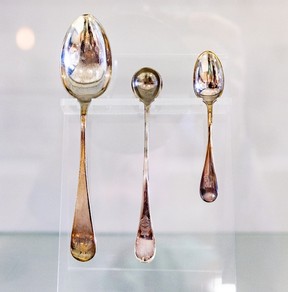
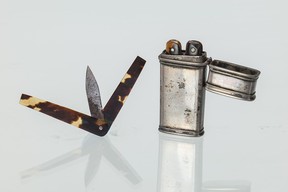
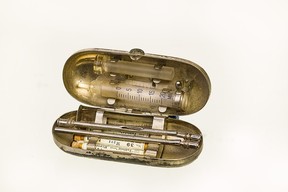
A series of arresting images by Nik Mirus, a still-life photographer based in Montreal, illustrate some of these historical objects: a lancet, a form of scalpel, in a tortoise-shell carapace dates to 1825. It came from a doctor’s pocket kit likely used in house calls and that pre-dates germ theory: The theory, developed in the 19th century, holds that microscopic organisms known as pathogens, or germs, are the cause of specific diseases.
“Things dramatically changed in that period,” said Kirsh. Such a lancet would not have been used later because tortoiseshell cannot be sterilized. Another pocket kit, dating to about 1925, held medication, needles and syringes. The collection features many different types of pocket kits. “All generally had a small set of tools commonly used at the time,” she said.
Another image by Mirus depicts a Crookes tube, a vacuum-sealed handblown glass container capable of carrying electricity. It was invented by English chemist Sir William Crookes (1832-1919) to study gases and used later in experiments leading to the 1895 discovery of X-rays by Wilhelm Röentgen. The many applications of X-rays created the first practical use for these Crookes tubes, and workshops began to manufacture specialized Crookes tubes to generate X-rays.
Advertisement 11
Story continues below
Article content
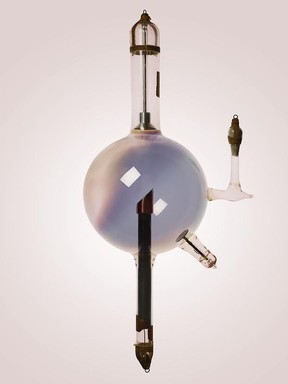
“Showcasing these objects emphasizes scientific progress, but you can still marvel at the beauty and the craftsmanship of it,” said Kirsh, who recruited a number of retired members of the nursing and medical staff to help identify many objects in the initial assessment of the inventory.
She has an assistant and assistance from technical staff when she needs it, but the centre relies on volunteers to help with processing and research; most are students in management information systems, the field formerly known as library science, and others have such diverse backgrounds as archeology, chemistry and urban planning.
Lister’s Antiseptic Spray, used in operating theatres in the 1870s and the 1880s, filled the air with a pungent yellow mist of antiseptic called carbolic acid. It was invented by British surgeon Joseph Lister to kill airborne bacteria and reduce the chance of infection during surgery. Lister was inspired by experiments by French chemist Louis Pasteur, who developed modern germ theory in 1861: Pasteur proved that food spoiled because of contamination by invisible bacteria — not by spontaneous generation, which held that living creatures could arise from non-living matter. Although it was initially controversial, germ theory revolutionized public health.
Advertisement 12
Story continues below
Article content
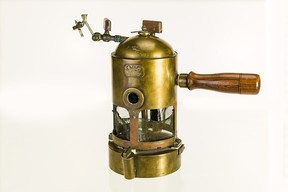
In 1872, a young McGill medical graduate and surgeon named Thomas Roddick (1846-1923), appalled by high mortality rates on surgical wards, visited Lister in Edinburgh, where he was working. Roddick would go on to become a dean of McGill’s medical faculty and is best known today as the name behind the gates at main entrance to the McGill campus — a gift his wife made in his honour after his death. Less well known is that Roddick was the surgeon who brought antiseptic practices to Canada.
When he began his career in the 1860s, major operations were performed only as a last resort because the risk of deadly post-operative wound infections was so high — 80 per cent in some cases. But because he was so junior, he lacked influence to bring Lister’s new practice to Montreal. Five years later, having acquired operating-room privileges at the Montreal General, Roddick returned to Scotland to train under Lister. He bought the disinfecting apparatus, brought it back to Montreal, started to use it right away — there is a photo by Mirus of the Lister spray apparatus — and his post-operative mortality rate plummeted.
Advertisement 13
Story continues below
Article content
Lister’s antiseptic spray is one of Kirsh’s favourite objects in the collection. “This one invention revolutionized medicine and had a cascading effect,” she said. “Both Lister and Roddick began writing scientific papers on the impact of disinfection and this played a crucial role in proving germ theory.”
As a result, among other things, people began to wear gloves and hemlines of nurses’ uniforms rose gradually from ankle length to knee length in a reflection of improved understanding of how infection spread.
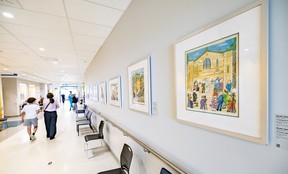
Artwork to spot, at a glance
Three of the founding hospitals of the MUHC are on the Glen campus in Notre-Dame-de-Grâce: the Royal Victoria, the Montreal Children’s and the Montreal Chest Institute. Other MUHC hospitals are elsewhere: The Montreal General still occupies the building on Cedar Ave. it moved into in 1955, the Montreal Neurological Institute-Hospital is on University St. above Pine Ave., the Allan Memorial Institute is on Pine Ave. and Lachine Hospital, which is being modernized and expanded, is in Lachine. All fall within the mandate of the RBC Art and Heritage Centre.
Advertisement 14
Story continues below
Article content
An exhibition on doctors and sportsmanship is on now at the Montreal General in a sixth-floor display case. A temporary exhibition of images of police and fire stations by photographer Brian Merrett (1945-2023), known for his contributions to the preservation of Montreal’s architectural heritage, has been hung in the resource centre near the main entrance to the Glen site. Also on the Glen campus, a temporary exhibition by contemporary artist and photographer Denis Farley, Empirical Iterations, is on until November in the atrium of the Research Institute, one of several gallery spaces on the campus.
Farley’s work Clouds and a wall mural by Shelley Miller at the entrance to the Royal Victoria wing, Structura Habitata, are two of 11 permanent public works on the Glen campus whose purchase was made possible by a provincial government policy requiring public construction projects to reserve about one per cent of their budget for public art by Quebec artists.
The Art and Heritage Centre also does digital work: This year, for instance, it has teamed up with McGill’s department of medicine to celebrate the 100th anniversary of the establishment of the University Medical Clinic, Canada’s first research department in an academic hospital. It was developed as both science and medical practice were becoming equally essential in academic training. The digital project mgh200.com was created for the 200th anniversary of the Montreal General and an online exhibition of female medical illustrators is in the works in collaboration with Digital Museums Canada.
Tours are given by trained volunteers on an as-requested basis. Email heritage@muhc.mcgill.ca.
Recommended from Editorial
Advertisement 15
Story continues below
Article content
Article content



Comments